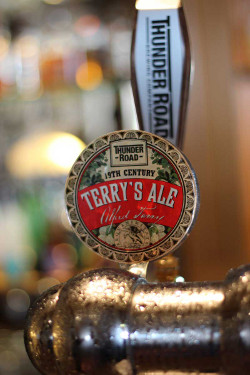
History revisited
The chance discovery of a historic notebook by beer historian Andrew Bailey created the opportunity to recreate a piece of Melbourne’s brewing past.
 The notebook was bought sight unseen from a bookshop in Maine USA. It didn’t take long for Bailey to recognise that the notebook was once the prized possession of Alfred Terry, one of Australia’s brewing pioneers. Evidently Terry had his important brewing calculations, tables, notes, and information bound into a notebook that he could easily carry with him.
The notebook was bought sight unseen from a bookshop in Maine USA. It didn’t take long for Bailey to recognise that the notebook was once the prized possession of Alfred Terry, one of Australia’s brewing pioneers. Evidently Terry had his important brewing calculations, tables, notes, and information bound into a notebook that he could easily carry with him.
At the back of the notebook was a beer recipe written in shorthand note form. The recipe was evidently from around the time when Terry became the brewer at the Carlton Brewery in 1865. The fact that the recipe was bound into his notebook indicates how important it was to Terry, and therefore was most likely the one that he brewed for the Carlton Brewery. Terry’s brewing knowledge and experience helped turn the brewery into a successful business. He stayed on as brewer until 1881. (It was not until 1907 that Carton Brewery joined with other breweries to form Carlton and United Breweries.)
Bailey enlisted the help of Thunder Road brewer Marcus Cox to make sense of the scrawled recipe. Together they were able to reconstruct the recipe in a way that could be followed. When shown the recipe, Thunder Road owner Philip Withers was thrilled with the opportunity to recreate this significant beer that had not been brewed for over one hundred years at his brewery.
Some of the ingredients that were used back then are still readily available, but others are harder to come by. English yeasts are still commonly used and the English hop variety, Goldings, was sourced from Tasmania. However, unrefined sugar is different from brown or raw sugars that we can readily buy today. So this had to be sourced from Mauritius. To get malt that was similar to that used in Terry’s recipe, Cox bought used some pale English malts and then “amberised” them in an oven.
The brewing process was not straightforward either. It required two mashes and two boils without any sparging. Cox had some trepidation about brewing this way, but at the same time, it was exciting to be able to bring this old beer back to life. The brew was then allowed to ferment at a higher temperature than most beers are brewed at today. After dry hopping with the Golding hops, it was just a matter of waiting for the fermentation to finish so that they could have a taste of this recreated history.
 Withers arranged for the beer to have its first public tasting at the iconic Young & Jacksons hotel that would have originally served the first version of this beer. Some of Terry’s descendants were invited down to taste this piece of their forefather’s history. Proceeds from the sale of this batch of Terry’s Ale will go to medical research at the Griffith University Institute for Glycomics.
Withers arranged for the beer to have its first public tasting at the iconic Young & Jacksons hotel that would have originally served the first version of this beer. Some of Terry’s descendants were invited down to taste this piece of their forefather’s history. Proceeds from the sale of this batch of Terry’s Ale will go to medical research at the Griffith University Institute for Glycomics.
My 110mL sample of the 5.9% Terry’s Ale had a concentrated golden colour with a slight haze and a dense white head. On the palate, it had a tart malt flavour with low bitterness. The cloying sweetness remains long after the other flavours disappear and is perhaps not well balanced by today’s standards.
Context, of course, plays a large part in our perceptions of flavour and enjoyment. Some of the other drinkers, that afternoon, thought it was very enjoyable and tasted noticeably English. Drinking this piece of reborn history, at Young & Jacksons with some of Terry’s family, while being watched over by the famous Chloe certainly added to the enjoyment.
There is no denying that a lot of time and planning went into recreating this piece of Melbourne’s brewing history. Arthur Terry’s success at brewing good beers reinvigorated the Carlton Brewery and has influenced the shape of breweries in Australia today. If there is sufficient demand, Terry’s Ale will again be brewed on a commercial scale in Victoria. Welcome to back to the 1870s!
Follow Rick Besserdin on Twitter.
Andrew Bailey is the author of the excellent The Brewery: Carlton Brewery a very worthy addition to any beer bookshelf.



